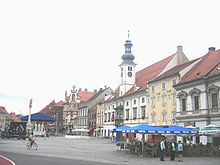| Marburg's Bloody Sunday | |
|---|---|
| Part of the Austro-Slovene conflict in Carinthia | |
 Main city square in Maribor (Marburg) where Marburg's Bloody Sunday took place. | |
| Coordinates | 46°33′28″N 15°38′44″E / 46.55778°N 15.64556°E |
| Date | 27 January 1919 |
| Target | Citizens of German ethnicity |
Attack type | Shooting |
| Deaths | 9–13 |
| Injured | 60+ |
| Perpetrators | Troops from the Kingdom of Serbs, Croats and Slovenes under the command of Slovene officer Rudolf Maister |
Marburg's Bloody Sunday (German: Marburger Blutsonntag,[1][2] Slovene: Mariborska krvava nedelja) was a massacre that took place on Monday, 27 January 1919 in the city of Maribor (German: Marburg an der Drau) in Slovenia. Soldiers from the army of the Kingdom of Serbs, Croats and Slovenes (later Yugoslavia), under the command of Slovene officer Rudolf Maister, killed between 9 and 13 civilians of German ethnic origin, wounding a further 60, during a protest in a city centre square. Estimates of casualties differ between Slovene and Austrian sources.
In November 1918, after the First World War ended, the territories of southern Carinthia and southern Styria, which had been claimed by both the Republic of German Austria and the State of Slovenes, Croats and Serbs, were captured by military units under Maister's command.
Maribor was the largest city of southern Styria and had a predominately German population, while the surroundings were almost exclusively Slovene. A US delegation led by Sherman Miles visited Maribor on 27 January 1919 as part of a wider mission to resolve territorial disputes. On the same day, German citizens organised a protest proclaiming their desire for Maribor to be incorporated into the Republic of German Austria. When the German protesters attacked the Slovenian police commissioner Ivan Senekovič, Maister's soldiers fired shots into the air and later at the people, causing few casualties. In response, German Austria launched a military offensive which expelled the Yugoslavs from several small towns in Central Styria along the Mur River. A ceasefire was agreed under the mediation of France in February 1919. According to the Treaty of Saint-Germain-en-Laye, signed on 10 September 1919, Maribor and the rest of Lower Styria became part of the Kingdom of Serbs, Croats and Slovenes. No one was ever charged over the Maribor shooting.
- ^ Goldinger, Walter; Dieter A. Binder (1992). Geschichte der Republik Österreich: 1918-1938 (in German). Vienna, Austria: Verlag fur Geschischte und Politik. p. 62. ISBN 9783702803155.
Marburger Blutsonntag
- ^ Ude, Lojze (1961). "Boj za Maribor" (pdf) (in Slovenian). Slovenia: Zgodovinski časopis. p. 138. Archived from the original on August 3, 2020. Retrieved January 11, 2011.
Tako je prišlo do demonstracij, ki jih je nacionalistični del nemške publistike zaradi streljanja, do katerega je prišlo na Glavnom Trgu pred Mestno Hišo, še danes oznečuje Der Marburger Bluttag...